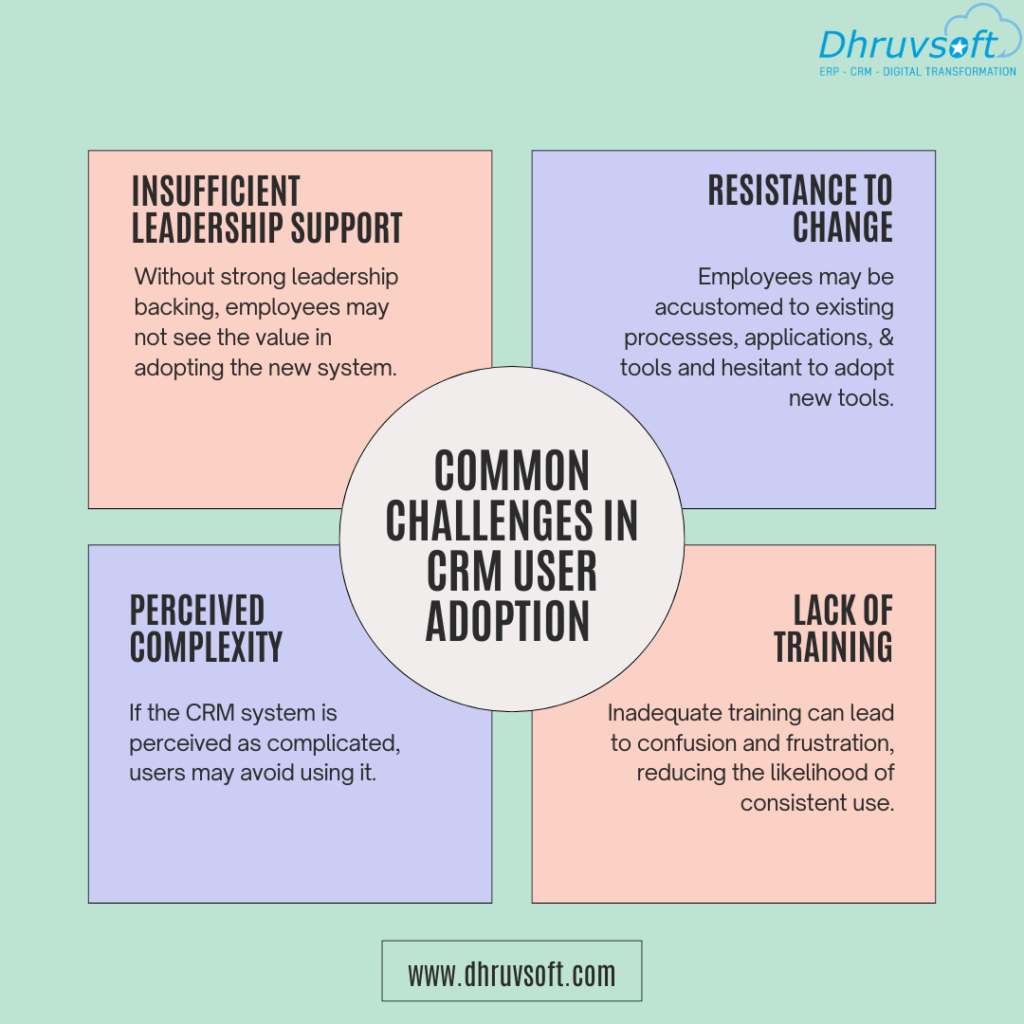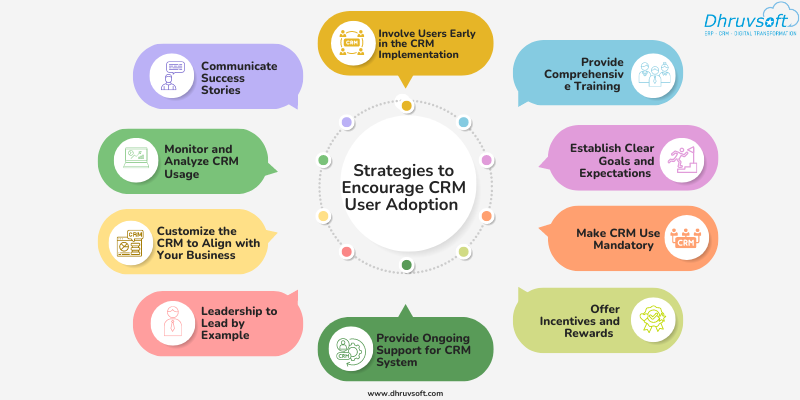Strategies to Encourage and Maintain High Levels of CRM User Engagement
Implementing a new Customer Relationship Management (CRM) system is a significant investment for any organization. However, the success of this investment largely depends on how well the system is adopted by its users.
Ensuring user adoption is not just about training employees to use the new tool but also about creating a culture that supports and encourages consistent use of the CRM system. This article will explore strategies to encourage and maintain high levels of user engagement with your new CRM, ensuring a smooth transition and long-term success.

What is the importance of CRM User Adoption
Before diving into the strategies, it’s essential to understand why user adoption is critical. A CRM system is designed to streamline processes, improve customer relations, and enhance productivity. But without proper adoption, these benefits are lost. Poor adoption can lead to inconsistent data, missed opportunities, and reduced return on investment (ROI).
What are the Common Challenges in CRM User Adoption
Several challenges can hinder CRM adoption by users, including:
- Resistance to Change: Employees may be accustomed to existing processes, applications, & tools and hesitant to adopt new tools.
- Lack of Training: Inadequate training can lead to confusion and frustration, reducing the likelihood of consistent use.
- Perceived Complexity: If the CRM system is perceived as complicated, users may avoid using it.
- Insufficient Leadership Support: Without strong leadership backing, employees may not see the value in adopting the new system.
Strategies to Encourage CRM User Adoption
1. Involve Users Early in the CRM Implementation Process
Involving key users in the CRM selection process can significantly impact adoption. When employees feel their input and feedback is valued, they are more likely to support the new system. We should conduct surveys or focus groups to gather feedback from users on what features of CRM are most important to them. Involve the key users during the implementation process for requirements gathering and User Acceptance Testing (UAT) as well. This involvement can lead to a system that better meets the organization’s needs and is more likely to be embraced by its users – leading to higher User Adoption.
2. Provide Comprehensive Training of New CRM System
Training is one of the most critical components of successful CRM adoption by end users. It’s essential to offer various training options to cater to different learning styles, including:
- In-Person Workshops: Hands-On training sessions allow users to ask questions and get immediate feedback.
- Online Tutorials: Video tutorials and webinars can provide flexible learning opportunities for employees who may not be able to attend in-person sessions.
- User Manuals and Documentation: Providing detailed documentation ensures users have a reference guide when they need help.
The CRM Training should be ongoing, and not just a one-time event at the start of the project. We recommend conducting monthly training sessions – that can be good for new joiners and can also be a good refresher for existing users, if they want to attend. As new features are added or updates are made to the system, ensure users are informed and trained on the changes.
3. Establish Clear Goals and Expectations for CRM
Setting clear goals and expectations for CRM use is essential for driving adoption. Employees need to understand why the CRM system is being implemented and how it will benefit them and the organization. Establish key performance indicators (KPIs) to measure the system’s success and communicate these metrics to all users.
For example, if one of the goals is to increase sales efficiency, set specific targets for the number of leads or opportunities entered into the CRM. Regularly track and share progress towards these goals to keep users engaged and motivated.
4. Make CRM Use Mandatory
While it may seem harsh, making CRM use mandatory can be an effective strategy for ensuring adoption. When employees understand that using the CRM is not optional, they are more likely to invest time in learning and using the system. However, this approach should be balanced with support, training, and encouragement rather than punishment for noncompliance.
Ensure that users are reviewed or evaluated based on the data in CRM. That way they will be more likely to stay invested with the system.
5. Offer Incentives and Rewards
Incentives and rewards to the users can be powerful motivators for CRM adoption. Consider offering rewards for users who consistently engage with the system, such as gift cards, recognition in company meetings, or even bonuses.
Gamifying the process by creating competitions or challenges can also drive engagement and make using the CRM more enjoyable.
6. Provide Ongoing Support for the CRM System
Even with comprehensive training, users may encounter challenges or have questions as they begin using the new CRM system. Providing ongoing support is crucial for maintaining adoption levels. This support can include:
- Dedicated Help Desk: Establish a help desk or support team for the CRM system that users can contact with questions or issues.
- Peer Support Groups: Encourage users to share tips and best practices with each other through internal forums or chat groups.
- Regular Check-Ins: Schedule regular check-ins with users to address any concerns and gather feedback on their experience with the CRM.
7. Leadership to Lead by Example
Leadership plays a crucial role in driving CRM adoption. When leaders actively use the CRM system and demonstrate its value, employees are more likely to follow suit.
Encourage managers and executives to integrate CRM use into their daily routines and to communicate the system’s importance regularly.
8. Customize the CRM to Align with Your Business Processes
One of the reasons CRM systems fail is that they don’t align with existing business processes. Customizing the CRM to fit your organization’s unique needs can make it easier for users to integrate the system into their workflows.
Work with your CRM vendor or CRM implementation partner to tailor the system to your specific processes and ensure it supports your business goals.
9. Monitor and Analyze CRM Usage
Regularly monitoring CRM usage can help identify areas where users may be struggling or not fully utilizing the system. Use in-built CRM reports and analytics tools to track user engagement, identify trends, and pinpoint areas for improvement. Share these insights with your team and use them to inform future training and support efforts.
10. Communicate Success Stories
Sharing success stories can be a powerful way to encourage CRM adoption. Highlight examples of how the CRM system has helped employees achieve their goals, such as closing deals faster, improving customer satisfaction, or streamlining processes.
Communicate these stories through company newsletters, meetings, or internal communication channels to inspire others to engage with the CRM.
Maintaining Long Term User Engagement
Once the initial adoption phase is complete, maintaining long-term engagement with the CRM system is essential. Here are some strategies to ensure users continue to use and benefit from the CRM:
1. Regularly Update and Improve the System
Technology is constantly evolving, and your CRM system should too should evolve to maintain user adoption. Regularly updating the CRM with new features and improvements can keep users engaged and excited about the system. Solicit feedback from users on what features they’d like to see and involve them in testing new updates before they are rolled out.
2. Encourage Continuous Learning
Promote a culture of continuous learning by offering ongoing training and development opportunities. This can include advanced training sessions, certifications, or workshops focused on specific CRM features or best practices. Encouraging employees to deepen their knowledge of the CRM system can lead to increased adoption and more effective use.
3. Foster a Collaborative Environment
Encourage collaboration among users by creating opportunities for them to share their experiences and learn from each other. This can include regular team meetings to discuss CRM usage, internal webinars or workshops, or even creating a user group where employees can share tips and best practices.
4. Recognize and Reward Long Term Users
Recognizing and rewarding employees who consistently engage with the CRM system can help maintain long-term adoption. This recognition can be as simple as a shout out in a team meeting or as significant as a bonus or promotion. Acknowledging the efforts of long-term users reinforces the importance of the CRM system and encourages others to follow suit.
5. Keep Leadership Involved
Leadership involvement should continue beyond the initial adoption phase. Regularly communicate the CRM system’s value to leadership and involve them in ongoing efforts to promote user engagement. When leaders remain committed to the system, it reinforces its importance to the entire organization.
Conclusion
Ensuring user adoption of a new CRM system is a multifaceted process that requires careful planning, consistent communication, and ongoing support. By involving users in the selection process, providing comprehensive training, setting clear expectations, and offering ongoing support, organizations can encourage and maintain high levels of user engagement with their CRM system.
Remember that CRM adoption is not a one-time event or project but it is an ongoing journey. By regularly updating the system, promoting continuous learning, and fostering a collaborative environment, organizations can ensure that their CRM system remains a valuable tool that drives business success for years to come.
Need help with reviewing User Adoption in your CRM implementation? Or need help implementing or optimizing your CRM system? Our team of CRM specialists is here to support you every step of the way. Contact us today to learn how we can help you achieve successful CRM adoption and drive long-term business growth.

